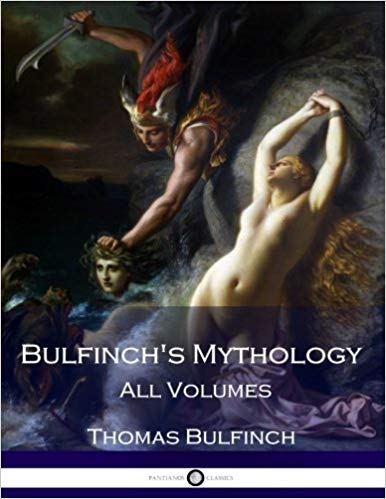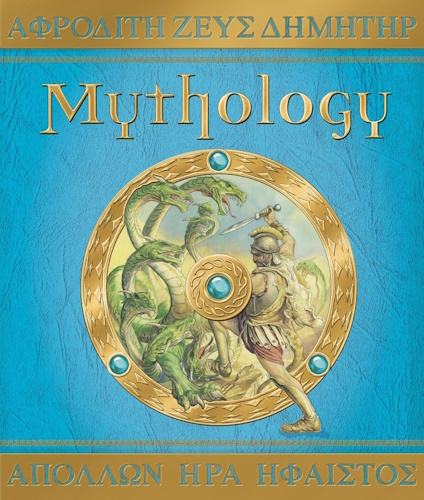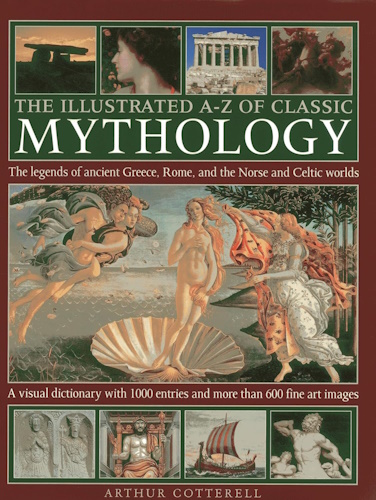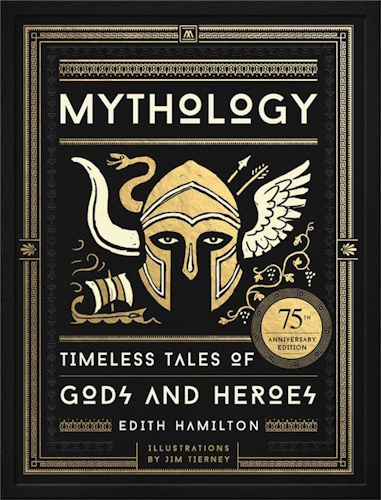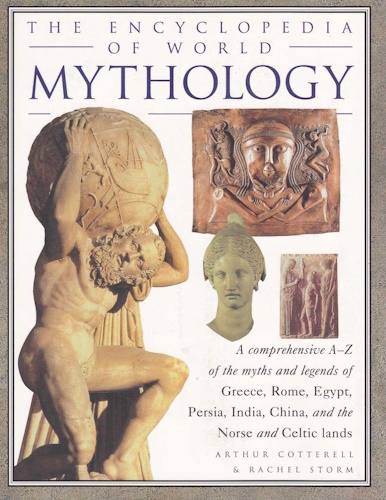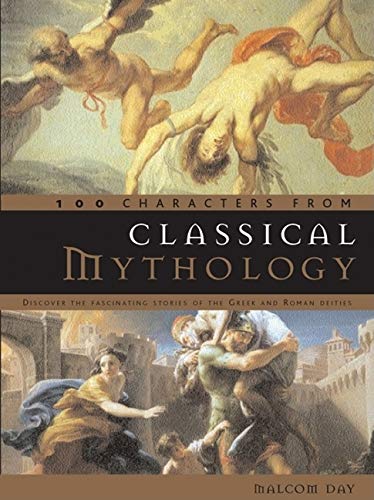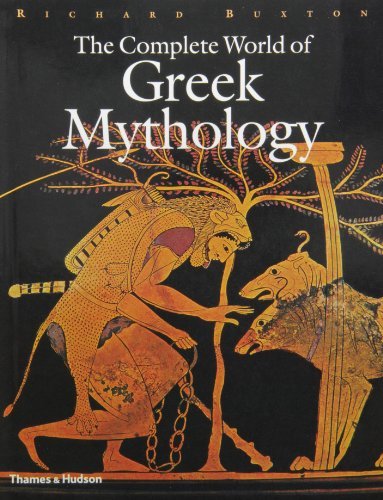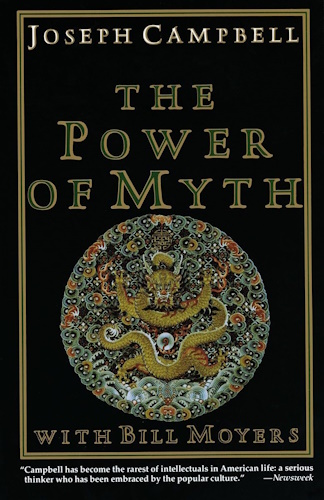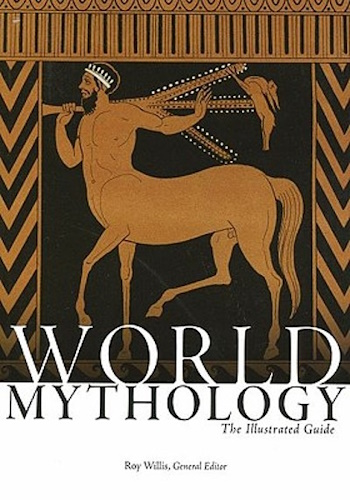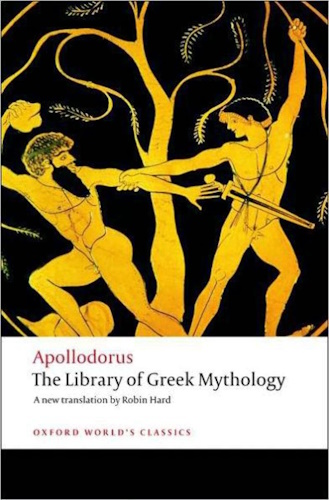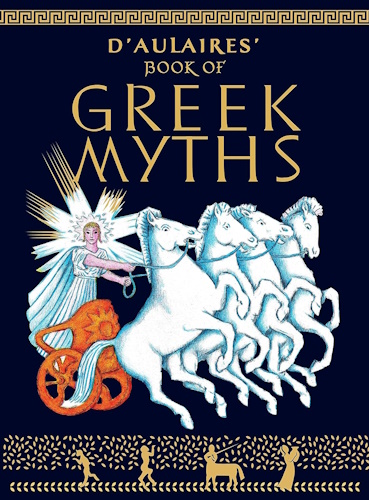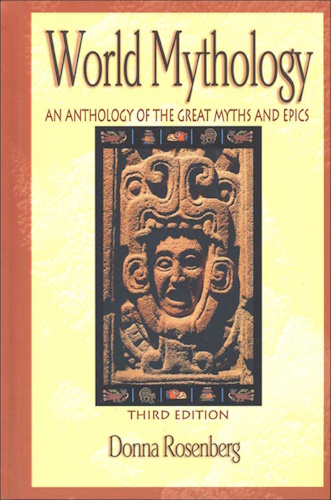
![]()
![]()
CHAPTER XIX.
HERCULES- HEBE AND GANYMEDE.
HERCULES.
HERCULES was the son of Jupiter and Alcmena. As Juno was always hostile to the offspring of her husband by mortal mothers, she declared war against Hercules from his birth. She sent two serpents to destroy him as he lay in his cradle, but the precocious infant strangled them with his own hands. He was, however, by the arts of Juno rendered subject to Eurystheus and compelled to perform all his commands. Eurystheus enjoined upon him a succession of desperate adventures, which are called the "Twelve Labours of Hercules." The first was the fight with the Nemean lion. The valley of Nemea was infested by a terrible lion. Eurystheus ordered Hercules to bring him the skin of this monster. After using in vain his club and arrows against the lion, Hercules strangled the animal with his hands. He returned carrying the dead lion on his shoulders; but Eurystheus was so frightened at the sight of it and at this proof of the prodigious strength of the hero, that he ordered him to deliver the account of his exploits in future outside the town.
His next labour was the slaughter of the Hydra. This monster ravaged the country of Argos, and dwelt in a swamp near the well of Amymone. This well had been discovered by Amymone when the country was suffering from drought, and the story was that Neptune, who loved her, had permitted her to touch the rock with his trident, and a spring of three outlets burst forth. Here the Hydra took up his position, and Hercules was sent to destroy him. The Hydra had nine heads, of which the middle one was immortal. Hercules struck off its heads with his club, but in the place of the head knocked off, two new ones grew forth each time. At length with the assistance of his faithful servant Iolaus, he burned away the heads of the Hydra, and buried the ninth or immortal one under a huge rock.
Another labour was the cleaning of the Augean stables. Augeas, king of Elis, had a herd of three thousand oxen, whose stalls had not been cleansed for thirty years. Hercules brought the rivers Alpheus and Peneus through them, and cleansed them thoroughly in one day.
His next labour was of a more delicate kind. Admeta, the daughter of Eurystheus, longed to obtain the girdle of the queen of the Amazons, and Eurystheus ordered Hercules to go and get it. The Amazons were a nation of women. They were very warlike and held several flourishing cities. It was their custom to bring up only the female children; the boys were either sent away to the neighbouring nations or put to death. Hercules was accompanied by a number of volunteers, and after various adventures at last reached the country of the Amazons. Hippolyta, the queen, received him kindly, and consented to yield him her girdle, but Juno, taking the form of an Amazon, went and persuaded the rest that the strangers were carrying off their queen. They instantly armed and came in great numbers down to the ship. Hercules, thinking that Hippolyta, had acted treacherously, slew her, and taking her girdle made sail homewards.
Another task enjoined him was to bring to Eurystheus the oxen of Geryon, a monster with three bodies, who dwelt in the island of Erytheia (the red), so called because it lay at the west, under the rays of the setting sun. This description is thought to apply to Spain, of which Geryon was king. After traversing various countries, Hercules reached at length the frontiers of Libya and Europe, where he raised the two mountains of Calpe and Abyla, as monuments of his progress, or, according to another account, rent one mountain into two and left half on each side, forming the straits of Gibraltar, the two mountains being called the Pillars of Hercules. The oxen were guarded by the giant Eurytion and his two-headed dog, but Hercules killed the giant and his dog and brought away the oxen in safety to Eurystheus.
The most difficult labour of all was getting the golden apples of the Hesperides, for Hercules did not know where to find them. These were the apples which Juno had received at her wedding from the goddess of the Earth, and which she had intrusted to the keeping of the daughters of Hesperus, assisted by a watchful dragon. After various adventures Hercules arrived at Mount Atlas in Africa. Atlas was one of the Titans who had warred against the gods, and after they were subdued, Atlas was condemned to bear on his shoulders the weight of the heavens. He was the father of the Hesperides, and Hercules thought might, if any one could, find the apples and bring them to him. But how to send Atlas away from his post, or bear up the heavens while he was gone? Hercules took the burden on his own shoulders, and sent Atlas to seek the apples. He returned with them, and though somewhat reluctantly, took his burden upon his shoulders again, and let Hercules return with the apples to Eurystheus.
Milton, in his "Comus," makes the Hesperides the daughters of Hesperus and niece of Atlas:
"...amidst the gardens fairOf Hesperus and his daughters three,
That sing about the golden tree."
The poets, led by the analogy of the lovely appearance of the western sky at sunset, viewed the west as a region of brightness and glory. Hence they placed in it the Isles of the Blest, the ruddy Isle Erytheia, on which the bright oxen of Geryon were pastured, and the Isle of the Hesperides. The apples are supposed by some to be the oranges of Spain, of which the Greeks had heard some obscure accounts.
A celebrated exploit of Hercules was his victory over Antaeus. Antaeus, the son of Terra, the Earth, was a mighty giant and wrestler, whose strength was invincible so long as he remained in contact with his mother Earth. He compelled all strangers who came to his country to wrestle with him, on condition that if conquered (as they all were) they should be put to death. Hercules encountered him, and finding that it was of no avail to throw him, for he always rose with renewed strength from every fall, he lifted him up from the earth and strangled him in the air.
Cacus was a huge giant, who inhabited a cave on Mount Aventine, and plundered the surrounding country. When Hercules was driving home the oxen of Geryon, Cacus stole part of the cattle, while the hero slept. That their footprints might not serve to show where they had been driven, be dragged them backward by their tails to his cave; so their tracks all seemed to show that they had gone in the opposite direction. Hercules was deceived by this stratagem, and would have failed to find his oxen, if it had not happened that in driving the remainder of the herd past the cave where the stolen ones were concealed, those within began to low, and were thus discovered. Cacus was slain by Hercules.
The last exploit we shall record was bringing Cerberus from the lower world. Hercules descended into Hades, accompanied by Mercury and Minerva. He obtained permission from Pluto to carry Cerberus to the upper air, provided he could do it without the use of weapons; and in spite of the monster's struggling, he seized him, held him fast, and carried him to Eurystheus, and afterwards brought him back again. When he was in Hades he obtained the liberty of Theseus, his admirer and imitator, who had been detained a prisoner there for an unsuccessful attempt to carry off Proserpine.
Hercules in a fit of madness killed his friend Iphitus, and was condemned for this offence to become the slave of Queen Omphale for three years. While in this service the hero's nature seemed changed. He lived effeminately, wearing at times the dress of a woman, and spinning wool with the hand-maidens of Omphale, while the queen wore his lion's skin. When this service was ended he married Dejanira and lived in peace with her three years. On one occasion as he was travelling with his wife, they came to a river, across which the Centaur Nessus carried travellers for a stated fee. Hercules himself forded the river, but gave Dejanira to Nessus to be carried across. Nessus attempted to run away with her, but Hercules heard her cries and shot an arrow into the heart of Nessus. The dying Centaur told Dejanira to take a portion of his blood and keep it, as it might be used as a charm to preserve the love of her husband.
Dejanira did so, and before long fancied she had occasion to use it. Hercules in one of his conquests had taken prisoner a fair maiden, named Iole, of whom he seemed more fond than Dejanira approved. When Hercules was about to offer sacrifices to the gods in honour of his victory, he sent to his wife for a white robe to use on the occasion. Dejanira, thinking it a good opportunity to try her love-spell, steeped the garment in the blood of Nessus. We are to suppose she took care to wash out all traces of it, but the magic power remained, and as soon as the garment became warm on the body of Hercules the poison penetrated into all his limbs and caused him the most intense agony. In his frenzy he seized Lichas, who had brought him the fatal robe, and hurled him into the sea. He wrenched off the garment, but it stuck to his flesh, and with it he tore away whole pieces of his body. In this state he embarked on board a ship and was conveyed home. Dejanira, on seeing what she had unwittingly done, hung herself. Hercules, prepared to die, ascended Mount OEta, where he built a funeral pile of trees, gave his bow and arrows to Philoctetes, and laid himself down on the pile, his head resting on his club, and his lion's skin spread over him. With a countenance as serene as if he were taking his place at a festal board he commanded Philoctetes to apply the torch. The flames spread apace and soon invested the whole mass.
Milton thus alludes to the frenzy of Hercules:
"As when Alcides* from OEchalia crownedWith conquest, felt the envenomed robe, and tore,
Through pain, up by the roots Thessalian pines
And Lichas from the top of OEta threw
Into the Euboic Sea."
* Alcides. a name of Hercules.
The gods themselves felt troubled at seeing the champion of the earth so brought to his end. But Jupiter with cheerful countenance thus addressed them: "I am pleased to see your concern, my princes, and am gratified to perceive that I am the ruler of a loyal people, and that my son enjoys your favour. For although your interest in him arises from his noble deeds, yet it is not the less gratifying to me. But now I say to you, Fear not. He who conquered all else is not to be conquered by those flames which you see blazing on Mount OEta. Only his mother's share in him can perish; what he derived from me is immortal. I shall take him, dead to earth, to the heavenly shores, and I require of you all to receive him kindly. If any of you feel grieved at his attaining this honour, yet no one can deny that he has deserved it." The gods all gave their assent; Juno only heard the closing words with some displeasure that she should be so particularly pointed at, yet not enough to make her regret the determination of her husband. So when the flames had consumed the mother's share of Hercules, the diviner part, instead of being injured thereby, seemed to start forth with new vigour, to assume a more lofty port and a more awful dignity. Jupiter enveloped him in a cloud, and took him up in a four-horse chariot to dwell among the stars. As he took his place in heaven, Atlas felt the added weight.
Juno, now reconciled to him, gave him her daughter Hebe in marriage.
The poet Schiller, in one of his pieces called the "Ideal and Life," illustrates the contrast between the practical and the imaginative in some beautiful stanzas, of which the last two may be thus translated:
"Deep degraded to a coward's slave,Endless contests bore Alcides brave,
Through the thorny path of suffering led;
Slew the Hydra, crushed the lion's might,
Threw himself, to bring his friend to light,
Living, in the skiff that bears the dead.
All the torments, every toil of earth
Juno's hatred on him could impose,
Well he bore them, from his fated birth
To life's grandly mournful close.
"Till the god, the earthly part forsaken,
From the man in flames asunder taken,
Drank the heavenly ether's purer breath.
Joyous in the new unwonted lightness,
Soared he upwards to celestial brightness,
Earth's dark heavy burden lost in death.
High Olympus gives harmonious greeting
To the hall where reigns his sire adored;
Youth's bright goddess, with a blush at meeting,
Gives the nectar to her lord."
S. G. B.
HEBE AND GANYMEDE.
Hebe, the daughter of Juno, and goddess of youth, was cup-bearer to the gods. The usual story is that she resigned her office on becoming the wife of Hercules. But there is another statement which our countryman Crawford, the sculptor, has adopted in his group of Hebe and Ganymede, now in the Athenaeum gallery. According to this, Hebe was dismissed from her office in consequence of a fall which she met with one day when in attendance on the gods. Her successor was Ganymede, a Trojan boy, whom Jupiter, in the disguise of an eagle, seized and carried off from the midst of his play-fellows on Mount Ida, bore up to heaven, and installed in the vacant place.
Tennyson, in his "Palace of Art," describes among the decorations on the walls a picture representing this legend:
"There, too, flushed Ganymede, his rosy thighHalf buried in the eagle's down,
Sole as a flying star shot through the sky
Above the pillared town."
And in Shelley's "Prometheus" Jupiter calls to his cup-bearer thus:
"Pour forth heaven's wine, Idaean Ganymede,And let it fill the Daedal cups like fire."
The beautiful legend of the "Choice of Hercules" may be found in the "Tatler," No. 97.
-
Urantia Book, 44:0.11 - The Celestial Artisans
Never in your long ascendancy will you lose the power to recognize your associates of former existences. Always, as you ascend inward in the scale of life, will you retain the ability to recognize and fraternize with the fellow beings of your previous and lower levels of experience. Each new translation or resurrection will add one more group of spirit beings to your vision range without in the least depriving you of the ability to recognize your friends and fellows of former estates.
-
Princess Bride 1987 Wallace Shawn (Vizzini) and Mandy Patinkin (Inigo Montoya)
Vizzini: HE DIDN'T FALL? INCONCEIVABLE.
Inigo Montoya: You keep using that word. I do not think it means what you think it means. -
Urantia Book, 117:4.14 - The Finite God
And here is mystery: The more closely man approaches God through love, the greater the reality -- actuality -- of that man. The more man withdraws from God, the more nearly he approaches nonreality -- cessation of existence. When man consecrates his will to the doing of the Father's will, when man gives God all that he has, then does God make that man more than he is.
-
Urantia Book, 167:7.4 - The Talk About Angels
"And do you not remember that I said to you once before that, if you had your spiritual eyes anointed, you would then see the heavens opened and behold the angels of God ascending and descending? It is by the ministry of the angels that one world may be kept in touch with other worlds, for have I not repeatedly told you that I have other sheep not of this fold?"
-
Urantia Book, Foreword - 0:12.12 - The Trinities
But we know that there dwells within the human mind a fragment of God, and that there sojourns with the human soul the Spirit of Truth; and we further know that these spirit forces conspire to enable material man to grasp the reality of spiritual values and to comprehend the philosophy of universe meanings. But even more certainly we know that these spirits of the Divine Presence are able to assist man in the spiritual appropriation of all truth contributory to the enhancement of the ever-progressing reality of personal religious experience—God-consciousness.
-
Urantia Book, 1:4.3 - The Mystery Of God
When you are through down here, when your course has been run in temporary form on earth, when your trial trip in the flesh is finished, when the dust that composes the mortal tabernacle "returns to the earth whence it came"; then, it is revealed, the indwelling "Spirit shall return to God who gave it." There sojourns within each moral being of this planet a fragment of God, a part and parcel of divinity. It is not yet yours by right of possession, but it is designedly intended to be one with you if you survive the mortal existence.
-
Urantia Book, 1:4.1 - The Mystery Of God
And the greatest of all the unfathomable mysteries of God is the phenomenon of the divine indwelling of mortal minds. The manner in which the Universal Father sojourns with the creatures of time is the most profound of all universe mysteries; the divine presence in the mind of man is the mystery of mysteries.
-
Urantia Book, 1:4.6 - The Mystery Of God
To every spirit being and to every mortal creature in every sphere and on every world of the universe of universes, the Universal Father reveals all of his gracious and divine self that can be discerned or comprehended by such spirit beings and by such mortal creatures. God is no respecter of persons, either spiritual or material. The divine presence which any child of the universe enjoys at any given moment is limited only by the capacity of such a creature to receive and to discern the spirit actualities of the supermaterial world.
-
Urantia Book, 11:0.1 - The Eternal Isle Of Paradise
Paradise is the eternal center of the universe of universes and the abiding place of the Universal Father, the Eternal Son, the Infinite Spirit, and their divine co-ordinates and associates. This central Isle is the most gigantic organized body of cosmic reality in all the master universe. Paradise is a material sphere as well as a spiritual abode. All of the intelligent creation of the Universal Father is domiciled on material abodes; hence must the absolute controlling center also be material, literal. And again it should be reiterated that spirit things and spiritual beings are real.
-
Urantia Book, 50:6.4 - Planetary Culture
Culture presupposes quality of mind; culture cannot be enhanced unless mind is elevated. Superior intellect will seek a noble culture and find some way to attain such a goal. Inferior minds will spurn the highest culture even when presented to them ready-made.
-
Urantia Book, 54:1.6 - True And False Liberty
True liberty is the associate of genuine self-respect; false liberty is the consort of self-admiration. True liberty is the fruit of self-control; false liberty, the assumption of self-assertion. Self-control leads to altruistic service; self-admiration tends towards the exploitation of others for the selfish aggrandizement of such a mistaken individual as is willing to sacrifice righteous attainment for the sake of possessing unjust power over his fellow beings.
-
Urantia Book, 54:1.9 - True And False Liberty
How dare the self-willed creature encroach upon the rights of his fellows in the name of personal liberty when the Supreme Rulers of the universe stand back in merciful respect for these prerogatives of will and potentials of personality! No being, in the exercise of his supposed personal liberty, has a right to deprive any other being of those privileges of existence conferred by the Creators and duly respected by all their loyal associates, subordinates, and subjects.
-
Urantia Book, 54:1.8 - True And False Liberty
There is no error greater than that species of self-deception which leads intelligent beings to crave the exercise of power over other beings for the purpose of depriving these persons of their natural liberties. The golden rule of human fairness cries out against all such fraud, unfairness, selfishness, and unrighteousness.
